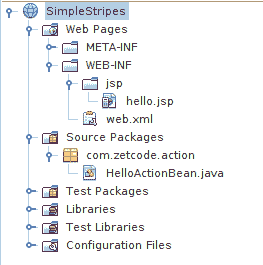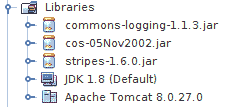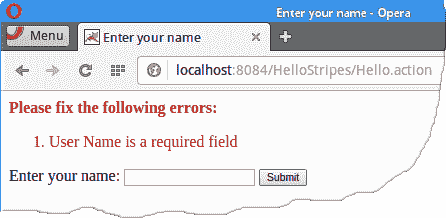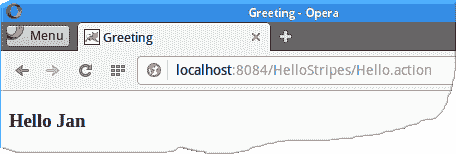原文:http://zetcode.com/java/stripes/
这是 Stripes 入门教程。 我们使用 Stripes Web 框架创建两个简单的 Web 应用。 我们使用 NetBeans 来构建应用。
Stripes 是一个开源的轻量级 Java Web 应用框架。 Stripes 的目标是使 Java 中基于 Servlet/JSP 的 Web 开发变得简单,直观和直接。 Stripes 是基于动作的 MVC(模型视图控制器)框架。 它运行在 JEE Web 容器中,使用最少的配置文件,并具有灵活和简单的参数绑定。
Stripes 的ActionBean是一个对象,用于接收在请求中提交的数据并处理用户的输入。 它既定义了表单的属性,又定义了表单的处理逻辑。 Stripes 会在部署时通过扫描 Web 应用的类路径来自动发现ActionBean。 条带过滤器的ActionResolver.Packages init-param(在web.xml中)设置一个或多个包根。
分辨率是作为对已处理请求的响应而创建的对象。 解决方案可以转发到 JSP 页面,流数据或返回错误消息。 分辨率由ActionBeans的处理器方法返回。
从 Stripes 的 Github 页面中,我们下载了最新的 Stripes 版本。 在lib子目录中,我们需要在项目中包含三个 JAR 文件:commons-logging-1.1.3.jar,cos-05Nov2002.jar和stripes-1.6.0.jar。 此外,还有StripesResources.properties文件,其中包含各种消息。
简单 Stripes 应用
第一个应用显示当前日期。 我们在 NetBeans 中创建一个新的 Web 应用。 我们选择 Tomcat 作为我们的 JSP/servlet 硬币容器。

图:项目文件
该项目包含三个文件:HelloActionBean.java包含响应我们请求的代码,showDate.jsp是作为响应发送回用户的视图,而web.xml文件包含用于设置 Stripes 的配置。 在此应用中,我们不使用StripesResources.properties。

图:项目库
这些是我们构建 Stripes 应用所需的库。
web.xml
<?xml version="1.0" encoding="UTF-8"?><web-app xmlns="http://xmlns.jcp.org/xml/ns/javaee"xmlns:xsi="http://www.w3.org/2001/XMLSchema-instance"xsi:schemaLocation="http://xmlns.jcp.org/xml/ns/javaee http://xmlns.jcp.org/xml/ns/javaee/web-app_3_1.xsd"version="3.1"><filter><display-name>Stripes Filter</display-name><filter-name>StripesFilter</filter-name><filter-class>net.sourceforge.stripes.controller.StripesFilter</filter-class><init-param><param-name>ActionResolver.Packages</param-name><param-value>com.zetcode.action</param-value></init-param></filter><filter-mapping><filter-name>StripesFilter</filter-name><url-pattern>*.jsp</url-pattern><dispatcher>REQUEST</dispatcher></filter-mapping><filter-mapping><filter-name>StripesFilter</filter-name><servlet-name>StripesDispatcher</servlet-name><dispatcher>REQUEST</dispatcher></filter-mapping><servlet><servlet-name>StripesDispatcher</servlet-name><servlet-class>net.sourceforge.stripes.controller.DispatcherServlet</servlet-class><load-on-startup>1</load-on-startup></servlet><servlet-mapping><servlet-name>StripesDispatcher</servlet-name><url-pattern>*.action</url-pattern></servlet-mapping><welcome-file-list><welcome-file>Hello.action</welcome-file></welcome-file-list></web-app>
在标准web.xml部署描述符中,我们配置 Stripes。 我们指定 Stripes 在哪里寻找ActionBean:在我们的例子中是com.zetcode.action包。 欢迎文件是当我们请求主页时显示的文件。 Hello.action指示应执行HelloActionBean。
HelloActionBean.java
package com.zetcode.action;import java.util.Date;import net.sourceforge.stripes.action.ActionBean;import net.sourceforge.stripes.action.ActionBeanContext;import net.sourceforge.stripes.action.DefaultHandler;import net.sourceforge.stripes.action.ForwardResolution;import net.sourceforge.stripes.action.Resolution;public class HelloActionBean implements ActionBean {private static final String VIEW = "/WEB-INF/jsp/showDate.jsp";private ActionBeanContext context;private Date date;public Date getDate() {return date;}public void setDate(Date date) {this.date = date;}@Overridepublic void setContext(ActionBeanContext context) {this.context = context;}@Overridepublic ActionBeanContext getContext() {return context;}@DefaultHandlerpublic Resolution hello() {this.date = new Date();return new ForwardResolution(VIEW);}}
HelloActionBean处理请求,并以向前解析的方式响应 JSP 页面。
private static final String VIEW = "/WEB-INF/jsp/showDate.jsp";
该视图是showDate.jsp文件。
private ActionBeanContext context;
ActionBeanContext封装有关当前请求的信息。 如果我们出于任何原因需要使用它,它提供对底层 Servlet API 的访问。
@DefaultHandlerpublic Resolution hello() {this.date = new Date();return new ForwardResolution(VIEW);}
@DefaultHandler注解为此动作 bean 设置了默认处理器。 它用当前日期填充date属性,并返回一个新的ForwardResolution。 分辨率转发到视图。
showDate.jsp
<%@page contentType="text/html" pageEncoding="UTF-8"%><!DOCTYPE html><html><head><meta http-equiv="Content-Type" content="text/html; charset=UTF-8"><title>Current date</title></head><body><h3>The date is ${actionBean.date}</h3></body></html>
这是用户的模板视图。 ${actionBean}表达式引用指向此视图的操作 bean。 我们使用表达式来引用动作 bean 的date属性。
$ curl localhost:8084/SimpleStripes/<!DOCTYPE html><html><head><meta http-equiv="Content-Type" content="text/html; charset=UTF-8"><title>Current date</title></head><body><h3>The date is Thu Jun 02 14:13:01 CEST 2016</h3></body></html>
构建和部署应用之后,我们将使用curl工具访问应用的主页。 该应用将响应一个包含当前日期的 HTML 页面。
Hello Stripes 应用
在第二个应用中,我们有一个简单的 HTML 表单。 用户在文本框中指定其名称。 该应用以问候回应。 验证用于确保用户已在文本字段中输入了内容。
web.xml
<?xml version="1.0" encoding="UTF-8"?><web-app xmlns="http://xmlns.jcp.org/xml/ns/javaee"xmlns:xsi="http://www.w3.org/2001/XMLSchema-instance"xsi:schemaLocation="http://xmlns.jcp.org/xml/ns/javaee http://xmlns.jcp.org/xml/ns/javaee/web-app_3_1.xsd"version="3.1"><filter><display-name>Stripes Filter</display-name><filter-name>StripesFilter</filter-name><filter-class>net.sourceforge.stripes.controller.StripesFilter</filter-class><init-param><param-name>ActionResolver.Packages</param-name><param-value>com.zetcode.action</param-value></init-param></filter><filter-mapping><filter-name>StripesFilter</filter-name><url-pattern>*.jsp</url-pattern><dispatcher>REQUEST</dispatcher></filter-mapping><filter-mapping><filter-name>StripesFilter</filter-name><servlet-name>StripesDispatcher</servlet-name><dispatcher>REQUEST</dispatcher></filter-mapping><servlet><servlet-name>StripesDispatcher</servlet-name><servlet-class>net.sourceforge.stripes.controller.DispatcherServlet</servlet-class><load-on-startup>1</load-on-startup></servlet><servlet-mapping><servlet-name>StripesDispatcher</servlet-name><url-pattern>*.action</url-pattern></servlet-mapping><welcome-file-list><welcome-file>index.jsp</welcome-file></welcome-file-list></web-app>
在web.xml文件中,我们将index.jsp文件设置为欢迎文件。
index.jsp
<%@taglib prefix="stripes" uri="http://stripes.sourceforge.net/stripes.tld"%><%@page contentType="text/html" pageEncoding="UTF-8"%><!DOCTYPE html><html><head><meta http-equiv="Content-Type" content="text/html; charset=UTF-8"><title>Enter your name</title></head><body><stripes:form beanclass="com.zetcode.action.HelloActionBean"><stripes:errors/>Enter your name:<stripes:text name="userName"/><stripes:submit name="save" value="Submit"/></stripes:form></body></html>
index.jsp包含一个简单的 HTML 表单。 Stripes 具有自己的标签。 <stripes:errors/>显示验证错误。 如果我们未在该字段中写入任何文本,则会显示验证错误。 在<stripes:form>标记中,我们指定应处理请求的操作 bean。 <stripes:text/>创建一个文本字段。 创建的请求参数将自动映射到HelloActionBean的userName属性。

图:StripesResources.properties
StripesResources.properties是 Stripes 框架的默认资源包。 它包含各种消息和标签的值。 样本文件包含在 Stripes 下载文件的lib子目录中。 我们将文件放入源包中,未指定包。 (该文件应最终位于WEB-INF/classes目录中。)
StripesResources.properties
...validation.required.valueNotPresent={0} is a required field...
当我们在文本字段中未输入任何内容并单击“提交”按钮时,将显示此错误消息。
HelloActionBean.java
package com.zetcode.action;import net.sourceforge.stripes.action.ActionBean;import net.sourceforge.stripes.action.ActionBeanContext;import net.sourceforge.stripes.action.DefaultHandler;import net.sourceforge.stripes.action.ForwardResolution;import net.sourceforge.stripes.action.Resolution;import net.sourceforge.stripes.validation.Validate;public class HelloActionBean implements ActionBean {private static final String VIEW = "/WEB-INF/jsp/greet.jsp";private ActionBeanContext context;@Validate(required=true)private String userName;public String getUserName() {return userName;}public void setUserName(String userName) {this.userName = userName;}@Overridepublic void setContext(ActionBeanContext context) {this.context = context;}@Overridepublic ActionBeanContext getContext() {return context;}@DefaultHandlerpublic Resolution greet() {return new ForwardResolution(VIEW);}}
单击提交按钮时,将执行HelloActionBean。 request参数自动绑定到其userName属性。 默认处理器将转发到greet.jsp视图。
@Validate(required=true)private String userName;
@Validate注解用于强制验证表单的用户名字段。 如果未输入任何值,则会显示一条错误消息。

图:验证错误消息
我们应用中的第二个视图是greet.jsp。
greet.jsp
<%@page contentType="text/html" pageEncoding="UTF-8"%><%@taglib prefix="stripes" uri="http://stripes.sourceforge.net/stripes.tld"%><!DOCTYPE html><html><head><meta http-equiv="Content-Type" content="text/html; charset=UTF-8"><title>Greeting</title></head><body><h3>Hello ${actionBean.userName}</h3></body></html>
greet.jsp显示给用户的问候消息。 通过${actionBean.userName}表达式,我们获得了用户名。

图:问候语
该应用以一条简单消息响应。
在本教程中,我们使用 Stripes Web 框架创建了两个简单的 Web 应用。 您可能也对 ZetCode 的 Java 教程,验证过滤器教程, Java MVC 教程, Play 框架简介和 Spark Java, Stripes,MyBatis & Derby 教程或 EJB 教程感兴趣。

